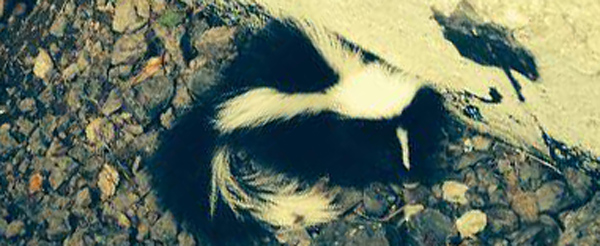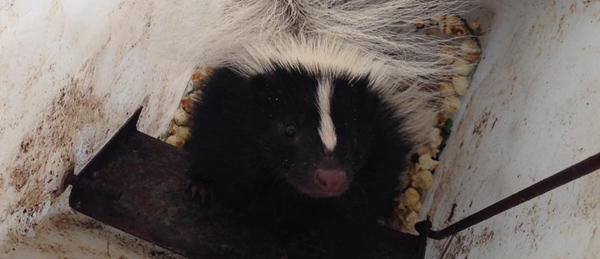- info@wildlife-removal.com
Call us for help in your town
Wildlife Removal Education
Is a skunk that is active during the day time rabid?
Need skunk removal in your hometown? We service over 500 USA locations! Click here to hire us in your town and check prices - updated for year 2020.
Not all of the time. A skunk may be active during the day without being rabid. Of a truth, rabid skunks display funny mannerisms, one of which is that they are seen moving around during daytime. Ordinarily, skunks are nocturnal and they do all of their foraging between dusk and dawn. But there are other reasons for unusual daytime activity apart from being rabid.

A hungry skunk, who probably hunted in vain the night before, may venture out at daytime to satisfy its basic need for food. This is more common with female skunks that have young ones back in their nest. She is likely to forage at daytime to feed herself or to get food for the babies. Such foods include insects, pet foods, small amphibians, vegetables, fruits, mice, eggs etc.
In the same vein, young and orphaned skunks may also be seen wandering around during the day as they search for a mother that is probably dead. Or food. They never stop searching until they find help or die of starvation.
Skunks may also proceed out of their dens in search for warmth in the cold of winter. At such times, the weather conditions of their dens may become really uncomfortable for them.
Unless a skunk shows other signs of being rabid, do not assume that it is suffering from rabies. Other signs of being rabid include convulsive movement, confusion, being fearless of humans, seizures with or without foaming in the mouth, looking drunk, stupor, paralysis, circling within a spot, vocalizing, stumbling, aggressiveness, nose or eyes discharge and so on.
Any skunk that wanders around during the day and displays any of these signs, is very likely to be suffering from rabies and such critters should be treated with caution. You may want to read about Are Skunks Dangerous To Pets?
Always ensure to wear protective hand gloves while handling or trapping a skunk, whether it is showing signs of being rabid or not.
Go back to the Skunk Removal page, or learn tips by reading How to get rid of skunks.
What diseases do skunks carry? Skunks do carry quite a number of diseases and this is why it is advisable to use hand gloves whenever you are handling skunks. Some of these diseases are listed below:

Rabies- Rabies is commonly associated with skunk, and they are said to be the second top carriers of the deadly disease after bats. Rabies is a viral disease that can affect both humans and animals. It can exist in the animal’s system for extended periods without any symptom, but as it progresses, some symptoms begin to manifest and they include paralysis, fever, loss of consciousness, uncontrollable movement, disorientation and fear of water. The viral load can be transmitted through saliva or mucous membrane.
Listeriosis- Listeriosis is a bacterial infection that rarely affects skunks, but when it does, it is usually fatal. The disease is contracted through food or water that has been infected by Listeria monocytogenes. Listeriosis often leads to a dysfunctional central nervous system with symptoms like convulsions, loss of balance, and so on. Read the full guide What Are The Symptoms of A Sick Skunk?
Q-fever- Skunks are usually infected by this disease when they come in contact with the urine, feces, virginal mucous or semen of infected animals. This disease, which can be transmitted to humans, causes muscle pain, fever, and diarrhea.
Tularemia- This bacterial infection is also called rabbit fever or deer fly fever. Fever is the most common symptom associated with tularemia.
Leptospirosis- Leptospirosis is another bacterial disease and it is caused by Lestospira. It habitually shows no symptoms until after about 12 days. It is transmitted through urine. Muscle pain is one of the major signs associated with leptospirosis.
Canine distemper- Canine distemper is a viral infection that is characterized with diarrhea, lethargy, vomiting, fever, nose discharge and other neurological disorders.
Canine hepatitis- Canine hepatitis can be easily contracted through physical contact with urine, saliva or feces of infected animals. It affects the eyes, lungs, liver, and kidney of the infected animal. Because canine hepatitis develops so quickly, it kills infected individual as there is little or no time to treat the animal before it dies off. Diarrhea, loss of appetite and jaundice are some of the symptoms that a skunk infected with canine hepatitis will show.
Most of these diseases are transferred when an infected animal bites a skunk. They can also be transmitted to the skunk when there is physical contact with the urine, feces or saliva of an infected animal. Skunks can also transmit these diseases to other animals, including humans; so adequate care must be taken whilst handling skunks and other animals.
You can read more about skunk diseases
Do Most Skunks Carry Rabies?
A lot of people have associated skunks with the rabies disease, and with good cause. But in truth, the percentage of skunks that are infected with the disease is far less than those without it. The only general problem that skunks have with rabies is that they are highly susceptible to being rabid compared to other animals, except for bats though.

As a matter of fact, a skunk can only be infected with rabies if it is bitten by another infected animal. Thus, not every skunk is rabid. It should also be noted that usually, rabies does not affect humans like it does animals. That is, the effects are not as severe in humans, even though bitten by an animal.
Rabies is a viral disease that affects the central nervous system of any animal that gets infected with it. More often than not, a rabid animal may show no symptoms of being infected for days. This makes it a serious threat because if this animal bites another one or a human during this period, it may not be taken seriously since it is not seen to be rabid. As a rule, whenever a skunk or another wild animal bites a person or pet, the bitten individual should be treated immediately.
Rabies is majorly transmitted via the saliva and mucous membranes when skunks bite a victim. Unlike a popular assumption that people have, skunks cannot transmit rabies through their feces, urines or the sulphuric fluid that they spray when threatened.
In order to identify a rabid skunk, look out for these signs – activeness during the daytime, seizures, unusual aggression, vocalizing, stumbling, foaming in the mouth, looking drunk, paralysis, circling movements, disorientation, and becoming extremely fearless of humans. The symptoms and signs displayed by a rabid skunk will usually depend on the type of rabies that plagues it – whether it is furious or dumb type. Furious rabies makes the animal become aggressive, while the dumb type will make the animal lose most of its normal functions.
To avoid being infected with rabies, exercise extreme caution around skunks and do all you can to avoid being bitten by one. Take all the necessary precautions while dealing with skunks or any wildlife; wear thick rubber gloves on your hands and rubber boots on your feet.
Go back to the Skunk Removal page.


















